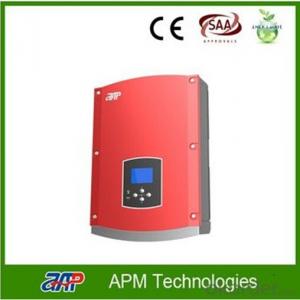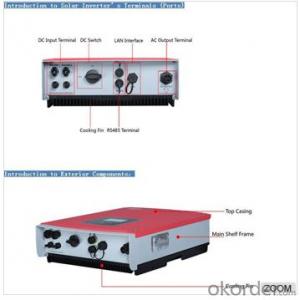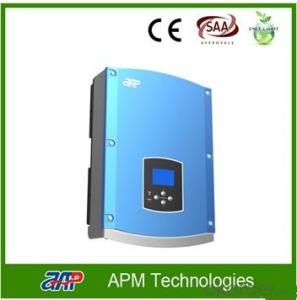Pv Inverter Single Phase Solar Inverter 1500W On Grid
- Loading Port:
- China main port
- Payment Terms:
- TT or LC
- Min Order Qty:
- 15000 watt
- Supply Capability:
- 3000000 watt/month
OKorder Service Pledge
OKorder Financial Service
You Might Also Like
1. Structure of Pv Inverter Single Phase Solar Inverter 1500W On Grid Description
1) Transformerless single phase on Grid pv Inverter
2)12v DC to 220v AC 1500W 50Hz/60Hz Solar Power Inverter, Pure Sine Wave Inverter.
3) IP 65 1500w On grid Pv Solar Inverter.
2. Main Features of the Pv Inverter Single Phase Solar Inverter 1500W On Grid
﹒High quality .
﹒competitive wholesale price.
﹒5years warranty
﹒Power Factor:>0.99 with nominal AC current
﹒AC Voltage Range:150V-550Vac
﹒Nominal AC Power:1500W
3. Pv Inverter Single Phase Solar Inverter 1500W On Grid Images

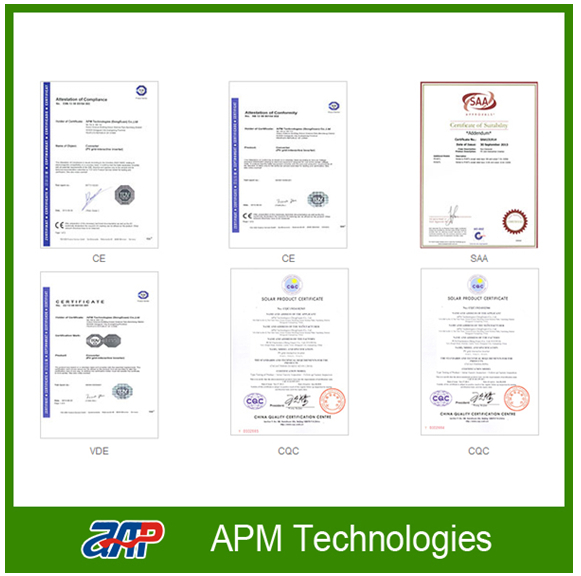
4. Pv Inverter Single Phase Solar Inverter 1500W On Grid Specification
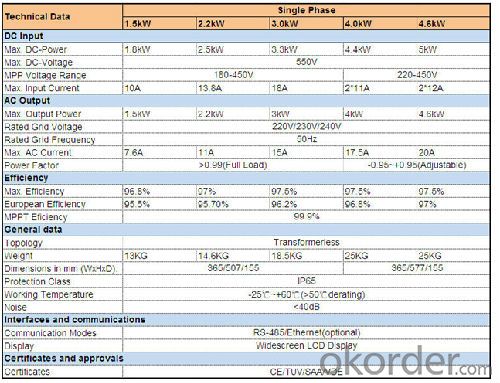
5. FAQ of Pv Inverter Single Phase Solar Inverter 1500W On Grid
Q1. What is the difference between inverter and solar inverter?
A1. Inverter only has AC inpput, but solar inverter both connect to AC input and solar panel, it saves more power.
Q2. What is the difference between MPPT&PWM?
A2. MPPT has higher efficiency, it can track the max power point and won't waste energy.
Q3. What is the waranty of product?
A3. 5 years .
- Q:Can a solar inverter be used with solar-powered recreational vehicles (RVs)?
- Yes, a solar inverter can be used with solar-powered recreational vehicles (RVs). Solar inverters convert the direct current (DC) generated by the solar panels into alternating current (AC) that can be used to power various appliances and devices in the RV. This allows RV owners to utilize solar energy for their electrical needs while on the road.
- Q:Can a solar inverter be used with a solar-powered heating system?
- Yes, a solar inverter can be used with a solar-powered heating system. The solar inverter converts the direct current (DC) generated by the solar panels into alternating current (AC) which can be used to power various appliances, including a heating system. This allows the solar panels to provide clean and renewable energy for heating purposes.
- Q:Can a solar inverter be used for both grid-tied and off-grid systems?
- No, a solar inverter cannot be used for both grid-tied and off-grid systems. Grid-tied inverters are designed to convert solar energy into electricity and feed it back into the grid, while off-grid inverters are designed to convert solar energy into usable electricity for standalone systems not connected to the grid. The requirements and functionalities of both types of systems are different, so separate inverters are needed for each.
- Q:Can a solar inverter be used with different types of tracking systems?
- Yes, a solar inverter can be used with different types of tracking systems. The function of a solar inverter is to convert the DC (direct current) generated by the solar panels into AC (alternating current) that can be used to power electrical devices. As long as the tracking system is capable of generating DC power from the solar panels, the solar inverter can be used to convert it into usable AC power.
- Q:Can a solar inverter be used with a solar-powered greenhouse system?
- Yes, a solar inverter can be used with a solar-powered greenhouse system. A solar inverter converts the direct current (DC) generated by solar panels into alternating current (AC) that can be used to power electrical devices in the greenhouse system. This allows for efficient utilization of solar energy for various applications such as lighting, ventilation, irrigation, and temperature control within the greenhouse.
- Q:Can a solar inverter be installed outdoors?
- Yes, a solar inverter can be installed outdoors. However, it is important to ensure that the inverter is designed to be weatherproof and can withstand the elements. Additionally, proper ventilation and protection from direct sunlight should be considered when installing the inverter outdoors.
- Q:What happens to excess solar energy generated by the inverter?
- Excess solar energy generated by the inverter can be either stored in batteries for later use or fed back into the electrical grid, depending on the setup of the solar power system.
- Q:Can a solar inverter be used with different types of communication protocols?
- Yes, a solar inverter can be used with different types of communication protocols. Modern solar inverters are designed to be compatible with various communication protocols such as Wi-Fi, Ethernet, Modbus, and RS485. This allows for seamless integration and monitoring of the solar inverter with different types of monitoring systems, smart home devices, or energy management systems.
- Q:What is the role of a solar inverter in voltage control?
- The role of a solar inverter in voltage control is to convert the direct current (DC) produced by solar panels into alternating current (AC) that is suitable for use in homes and businesses. Additionally, a solar inverter helps regulate and stabilize the voltage levels to ensure that the generated electricity matches the required voltage for the connected electrical appliances. This helps prevent overvoltage or undervoltage situations, ensuring a safe and efficient energy supply.
- Q:How does a solar inverter handle shading or partial obstruction of solar panels?
- A solar inverter typically addresses shading or partial obstruction of solar panels by employing a technology called maximum power point tracking (MPPT). This technology allows the solar inverter to constantly monitor the output of each individual solar panel and optimize the power generation by adjusting the voltage and current levels. By doing so, it minimizes the impact of shading or obstruction on the overall system performance, ensuring maximum energy production even in less than ideal conditions.
1. Manufacturer Overview |
|
|---|---|
| Location | |
| Year Established | |
| Annual Output Value | |
| Main Markets | |
| Company Certifications | |
2. Manufacturer Certificates |
|
|---|---|
| a) Certification Name | |
| Range | |
| Reference | |
| Validity Period | |
3. Manufacturer Capability |
|
|---|---|
| a)Trade Capacity | |
| Nearest Port | |
| Export Percentage | |
| No.of Employees in Trade Department | |
| Language Spoken: | |
| b)Factory Information | |
| Factory Size: | |
| No. of Production Lines | |
| Contract Manufacturing | |
| Product Price Range | |
Send your message to us
Pv Inverter Single Phase Solar Inverter 1500W On Grid
- Loading Port:
- China main port
- Payment Terms:
- TT or LC
- Min Order Qty:
- 15000 watt
- Supply Capability:
- 3000000 watt/month
OKorder Service Pledge
OKorder Financial Service
Similar products
New products
Hot products
Hot Searches
Related keywords
